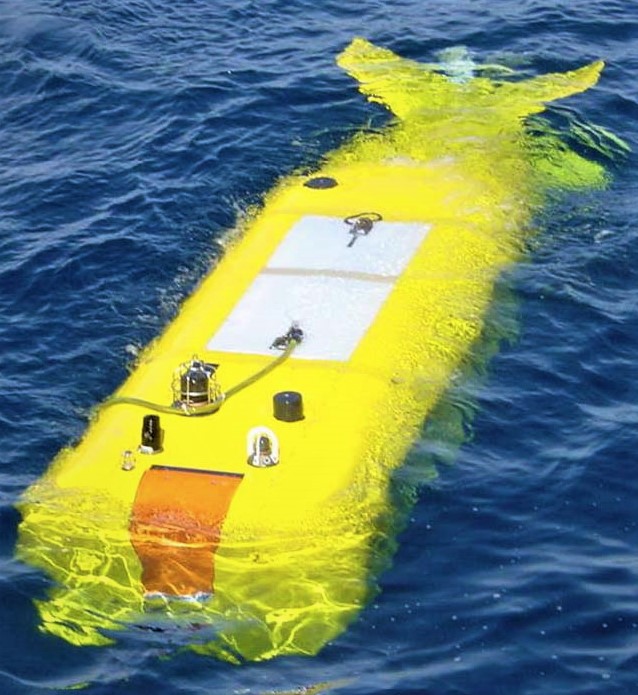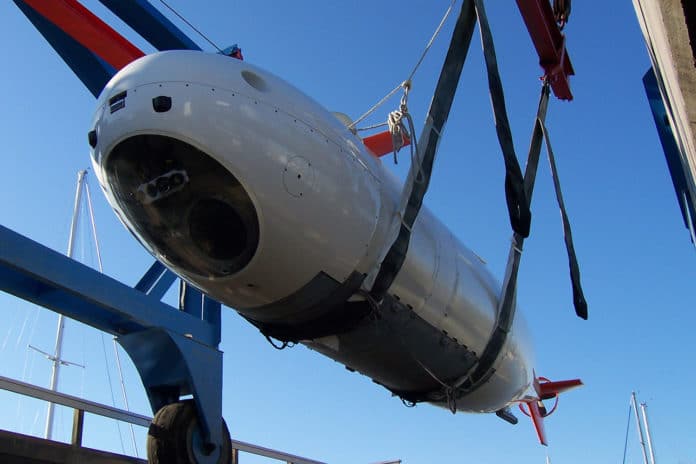
Just as unmanned drones have changed the complexion of warfare overhead in the sky they are now being replicated under the sea as global military powers inaugurate the development and deployment of unmanned underwater vessels (UUVs) to gain a strategic advantage in the Pacific Ocean and beyond. The United States, United Kingdom, China and Russia all are in the process of deploying these types of vessels ushering in the advent of the “dronification” of future subaquatic research operations and warfare.
The UK, which is currently expanding its military presence in the Pacific, is set to unveil its first extra-large underwater drone to complement its budding Astute-class submarine force. The Astute class is the future replacement for the existing Trafalgar-class fleet submarines in the Royal Navy Service. The Royal Navy’s efforts to design, build, and test such a drone have been designated as Project CETUS and proposes to produce a 27-ton, 12-meter Autonomous Underwater Vehicle (AUV) prototype model. The contract for Project CETUS is projected to be finalized in the financial year 2021-2022 with an estimated cost of $29.3 million. The Royal Navy is also developing the Manta underwater drone, an unmanned version of the existing S201 manned submersible built by MSubs, a British manufacturer.

Additionally, the United States is developing the analogous Orca Extra Large Unmanned Undersea Vehicle (XLUUV) and has awarded the Boeing Company contracts worth a total of $274.4 million to produce five Orca XLUUVs. The Orca can be deployed for sea-mine countermeasures, anti-submarine warfare, anti-surface warfare, electronic warfare (EW) and strike missions remotely and without risking the lives of manned operators.
China is also deploying underwater drones as evidenced by Indonesia’s recent seizure of three Chinese-made drones labeled “Shenyang Institute of Automation Chinese Academy of Sciences” near South Sulawesi’s Selayar Island in December 2020. That same year, China allegedly employed twelve “Sea Glider” underwater drones in the Indian Ocean to gather oceanographic data in support of its submarine operations. And it’s believed that China’s HSU001 unmanned underwater vehicle (UUV) can launch a smaller underwater drone. The HSU-001 underwater drone is comparable to the Project CETUS, Manta, and Orca drones and was tested off Fujian near the Taiwan Strait, simulating anti-submarine operations.
The proliferation of underwater drones in the Pacific region is altering the complexion of subsurface warfare as the region’s maritime environment poses unique operational challenges to underwater operations. The contested South China Sea is a semi-enclosed body of water with abundant unmapped underwater features and shallows that makes navigation hazardous for both crewed surface and underwater combatant vessels. However synchronously, the South China Sea provides an ideal operating environment for shallow-water conventional submarines as the area’s subaquatic features and noise from high cargo traffic enables such vessels to remain undetected for prolonged periods by exploiting these factors to mask their noise signatures. Therefore, by extension the South China Sea is an ideal proving ground for underwater drones as they can perform submerged tasks that may be too monotonous, demanding, hazardous or even dirty for humans to endure. The South China Sea disputes involve both island and maritime claims within the region by several sovereign states, namely Brunei, the People’s Republic of China (PRC), Taiwan (Republic of China/ROC), Indonesia, Malaysia, the Philippines, and Vietnam.

Too, underwater drones can be utilized for bathymetric mapping, in conjunction with recording the thermal, magnetic, and acoustic properties of specific underwater passages to discover blind spots where submarines can travel safely and undetected. As such, this capability is particularly suited for use in the South China Sea, which is among the most challenging bodies of water for submarine navigation due to its shallow waters, numerous underwater peaks and sandbars. The recent collision of the USN Attack submarine USS Connecticut SSN-22 with an unmapped seamount in the South China Sea exemplifies these hazards. In addition, these drones can also locate submarine “hiding spots” that serve as staging areas for underwater operations, or sanctuaries to avoid enemy anti-submarine warfare operations. And they have the potential to be used for mine-hunting and mine-laying operations. Underwater drones can scout underwater minefields and even disarm some naval mines. They may reduce, but not eliminate the need for specialized diver teams for reconnaissance operations, identify, and demine potential landing beaches for amphibious warfare operations. And they can also perform anti-submarine operations by actively searching and tracking enemy submarines without risking manned surface vessels or submarines. The use of underwater drones for anti-submarine purposes will thus minimize the need to commit manned warships for such operations.
More significantly, underwater drones can function as strategic weapons when nuclear-armed and can elude enemy missile defenses by stealthily operating submerged and slipping nearby or into major coastal cities’ ports and naval bases for attack purposes while evading detection. One such weapon is Russia’s Poseidon drone that provides Russia with a credible second-strike capability in the event of a nuclear attack from an enemy. Dubbed the “doomsday drone,” the Poseidon has a range of 620 miles and can carry a nuclear warhead with a yield of up to 100 megatons to most parts of the world while remaining immersed 3,300 feet beneath the surface.
The USN’s Orca is an autonomous extra-large unmanned undersea vehicle (XLUUV) being manufactured by the Boeing Company to meet the growing demand for undersea operational awareness and payload delivery. The navy will deploy the XLUUV for potential capabilities such as mine countermeasures, anti-surface warfare (ASUW), anti-submarine warfare (ASW), electronic warfare (EW) and strike missions. It’s a long-range underwater vehicle being developed to perform critical missions with reliability and it is expected to provide the ability to launch, recover, operate and establish communications with the vehicle from a home base away from the area of operation without the need for navy personnel. The underwater vehicles are expected to be delivered by June 2022 under a program to address a Joint Emergent Operational Need (JEON).
The US Navy selected Boeing and Lockheed Martin for the first phase of the XLUUV program with the companies securing design contracts in September 2017. The project aims to create an unmanned system that can operate independently at sea for months. The design contract awarded to Lockheed Martin was worth $43.17m, while the one awarded to Boeing was approximately $42.27m. The Navy intends to procure a total of nine vehicles under the program. Boeing won a $43m contract in the second phase of the competition to build, test and deliver four XLUUVs and related support elements in February 2019. Then a contract modification worth $46.7m was awarded to the company in March 2019 to produce an additional prototype vehicle, bringing the total contract value to $274m.
Boeing’s winning design for the Orca program is based on its Echo Voyager fully autonomous XLUUV, which was introduced in March 2016. The company tested various configurations of Echo Voyager and improved the performance of the platform. The vehicle underwent the first sea trial in 2017, while the second test was conducted in 2019. Echo Voyager has an overall length of 26m, including the length of added payload carriage. It is 2.6m-wide and weighs 50t in air. The submersible can carry out operations for months as it is fitted with a hybrid rechargeable power system and modular payload bay, and it can be launched and recovered without the requirement of support ships. Design work on Echo Voyager began at Boeing Phantom Works in 2011 to improve upon earlier AUV designs that required a manned support ship due to endurance of only a few days and a range of several hundred miles. Echo Voyager is intended to operate extended deep-sea missions at a depth of up to 11,000 feet far deeper than current military submarines capabilities and with a range of up to 7,500 miles and a mission endurance of six months. Echo Voyager is powered by a hybrid diesel-electric system. Submerged, the vehicle utilizes batteries for propulsion, which are recharged by a diesel-powered generator while it is surfaced. The system has a power output of about 18 kilowatts (24 hp) and allows Echo Voyager to travel submerged for several days at a time at up to 9 miles per hour. The 51-foot-long vessel is designed to be adaptable to either military or commercial use, with a payload bay that measures 30 feet by 8.5 feet.
Echo Voyager was built at Boeing’s Phantom Works facility in Huntington Beach CA in partnership with Huntington Ingalls Industries. Initial testing in an onshore pool was conducted in early 2016 with the first ocean tests off the California coast in the San Pedro Bay and near the Palos Verdes Peninsula from April through June 2017 to test the vehicle’s basic operational systems. Beginning in May 2018 and continuing for several more months, Boeing dispatched Echo Voyager on longer deep-sea tests that focused on the craft’s capability to operate fully autonomously. In February 2019, Boeing won a $43 million contract from the United States Navy for four ORCA AUVs based on the design of Echo Voyager.
Orca will feature a modular design with an open architecture and potential for reconfiguration that will provide guidance and control, autonomy, navigation and maneuvering capabilities. The XLUUV will be integrated with interfaces to allow for future upgrades to accommodate the latest technology and meet evolving threats. It will be able to travel to an area of operation, linger there, communicate, deploy payloads and then return to its home base. An active buoyancy control system aboard will provide capabilities, including autonomous buoyancy control, seafloor mooring and forward and aft trim control.
The vehicle’s navigation system includes Kalman filtered inertial navigation unit (INU), Doppler velocity logs (DVLs), depth sensors and seafloor long baseline (LBL) transponders. Echo Voyager is also equipped with GPS to support its operations on or near the surface. Encrypted Inmarsat IV, Iridium, Wi-Fi and FreeWave enabled communications are used for command, control and mission re-planning, while the vehicle performs near-surface operations. The submersible uses acoustic communications for command and control during submerged operations. Orca is expected to be equipped with forward-looking sonar (FLS) and autonomous obstacle avoidance algorithms to avoid obstacles. The FLS and the DVL facilitate terrain-following capability at the seabed. The modular payload bay will have the capacity to hold 8t of dry weight and the bay is powered by an 18kW battery. It will also accommodate external payloads and the payload bay will have interfaces to support requirements for existing and future payloads. The vehicle will be able to carry sonar payloads, including Raytheon PROSAS PS60-6000 synthetic aperture sonar for improved ocean floor mapping. Orca XLUUV will cruise at a minimum speed of 2.5k and a maximum speed of 8k with the optimal speed of the vehicle being in the range of 2.5k to 3k. It will offer an operational range of nearly 6,500nm. The vehicle will surface onto the water with its mast raised and automatically activate its diesel-powered generators when the onboard lithium-ion batteries are near depletion to await recovery and preparation for its next mission.
Although underwater drones may never completely replace manned submarines for submerged warfare, reconnaissance, oceanographic research and mapping they will certainly be a valuable additional asset far into the future that will cut costs of subaquatic operations while reducing the necessity to risk personnel for manned submerged operations.
